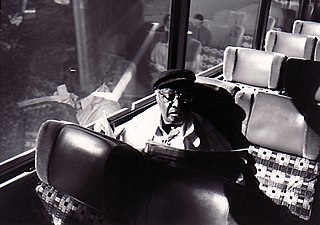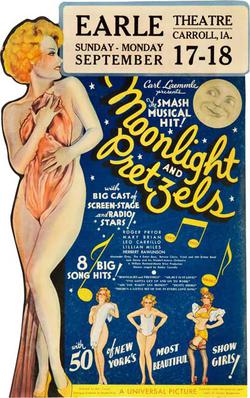Related Research Articles

A big band or jazz orchestra is a type of musical ensemble of jazz music that usually consists of ten or more musicians with four sections: saxophones, trumpets, trombones, and a rhythm section. Big bands originated during the early 1910s and dominated jazz in the early 1940s when swing was most popular. The term "big band" is also used to describe a genre of music, although this was not the only style of music played by big bands.

Theodore Leopold Friedman, known as Ted Lewis, was an American entertainer, bandleader, singer, and musician. He fronted a band and touring stage show that presented a combination of jazz, comedy, and nostalgia that was a hit with the American public before and after World War II. He was known by the moniker "Mr. Entertainment" or Ted "Is Everybody Happy?" Lewis. He died of lung failure in August 1971.

The New Orleans Rhythm Kings (NORK) were one of the most influential jazz bands of the early to mid-1920s. The band included New Orleans and Chicago musicians who helped shape Chicago jazz and influenced many younger jazz musicians.
Jazz standards are musical compositions that are an important part of the musical repertoire of jazz musicians, in that they are widely known, performed, and recorded by jazz musicians, and widely known by listeners. There is no definitive list of jazz standards, and the list of songs deemed to be standards changes over time. Songs included in major fake book publications and jazz reference works offer a rough guide to which songs are considered standards.

Roger Wolfe Kahn was an American jazz and popular musician, composer, bandleader and an aviator.

Giuseppe "Joe" Venuti was an American jazz musician and pioneer jazz violinist.

Milton John Hinton was an American double bassist and photographer.

Kansas City jazz is a style of jazz that developed in Kansas City, Missouri during the 1920s and 1930s, which marked the transition from the structured big band style to the much more improvisational style of bebop. The hard-swinging, bluesy transition style is bracketed by Count Basie, who in 1929 signed with Bennie Moten's Kansas City Orchestra, and Kansas City native Charlie Parker, who ushered in the bebop style in America. It has been said that while New Orleans was the birthplace of jazz, "America's music" grew up in Kansas City.
Territory bands were dance bands that crisscrossed specific regions of the United States from the 1920s through the 1960s. Beginning in the 1920s, the bands typically had 8 to 12 musicians. These bands typically played one-nighters, six or seven nights a week at venues like VFW halls, Elks Lodges, Lions Clubs, hotel ballrooms, and the like. Francis Davis, jazz critic for The Village Voice, likened territory bands to "the Top 40 cover bands of their day, typically relying on stock arrangements of other ensembles' hits." He said, "many historians give much credit to territory bands for popularizing modern ballroom dancing that began during the World War I era with the influence of Vernon and Irene Castle."

Moonlight and Pretzels is a 1933 American Pre-Code musical film, directed by Karl Freund, about a man who puts on a Broadway show. The film was released by Universal Studios and featured Mary Brian and William Frawley, now best-known as "Fred Mertz" on the 1950s TV show I Love Lucy; Freund was the groundbreaking cinematographer for I Love Lucy.
Harold "Scrappy" Lambert was an American dance-band vocalist who appeared on hundreds of recordings from the 1920s to the 1940s.

The period from the end of the First World War until the start of the Depression in 1929 is known as the "Jazz Age". Jazz had become popular music in America, although older generations considered the music immoral and threatening to cultural values. Dances such as the Charleston and the Black Bottom were very popular during the period, and jazz bands typically consisted of seven to twelve musicians. Important orchestras in New York were led by Fletcher Henderson, Paul Whiteman and Duke Ellington. Many New Orleans jazzmen had moved to Chicago during the late 1910s in search of employment; among others, the New Orleans Rhythm Kings, King Oliver's Creole Jazz Band and Jelly Roll Morton recorded in the city. However, Chicago's importance as a center of jazz music started to diminish toward the end of the 1920s in favor of New York.

Mabel Wayne was an American musician, composer and screenwriter. She is noted for being one of the first female composers to write successful hit songs. Her music career spanned from the 1920s until her death in 1978. Her songs included "In a Little Spanish Town" (1926), "Ramona" (1928), and "It Happened in Monterey" (1930).
Frank Christian Westphal was an American pianist, dance band leader and composer who recorded in the 1920s, following the end of his marriage to singer Sophie Tucker.
Harold J. Cromer was a vaudevillian, Master of Ceremony, Hoofer, Choreographer, and Comedian. He was known as Stumpy in the dance/comedy/acting duo Stump and Stumpy.
Mike Danzi was an American jazz and light music banjoist, guitarist, and bandleader. He has been cited as one of several musicians who successfully transplanted American popular musical genres to Germany during the 1920s and authored a valuable eyewitness account of the evolution of popular music in Germany prior to World War II.

The mandolin has had a place in North American culture since the 1880s, when a "mandolin craze" began. The continent was a land of immigrants, including Italian immigrants, some of whom brought their mandolins with them. In spite of the mandolin having arrived in America, it was not in the cultural consciousness until after 1880 when the Spanish Students arrived on their international performing tour. Afterwards, a "mandolin craze" swept the United States, with large numbers of young people taking up the instrument and teachers such as Samuel Siegel touring the United States. The fad died out after World War I, but enough had learned the instrument that it remained. The mandolin found a new surge with the music of Bill Monroe; the Gibson F-5 mandolin he played, as well as other archtop instruments, became the American standard for mandolins. Bowlback mandolins were displaced. The instrument has been taken up in blues, bluegrass, jug-band music, country, rock, punk and other genres of music. While not as popular as the guitar, it is widespread across the country.

The Kim Loo Sisters were an American jazz vocal quartet popular during the swing era. The close harmony group consisted of Alice, Margaret “Maggie” Genevieve “Jenée” and Patricia “Bubbles”.
Elliot James Carpenter was an American pianist, composer, arranger and writer.
References
- 1 2 3 "Obituaries: Milt Britton", Variety, May 1948, p.71
- 1 2 Trav SD, "The Britton Band: Musical Maniacs", Travalanche, July 8, 2019
- ↑ Kevin Whitehead, Play the Way You Feel: The Essential Guide to Jazz Stories on Film, Oxford University Press, 2020, ISBN 9780190847579, p.18
- ↑ Noal Cohen, "Tiny Kahn Discography". Retrieved 27 November 2023
- ↑ "Milt Britton Dies After Leading Orchestra At Luncheon of Radio Executives Club", New York Times, April 30, 1948, ,p.24
- ↑ "Skits, gags and 'Hellzapoppin'", Long Island Herald, August 31, 2016. Retrieved November 28, 2023